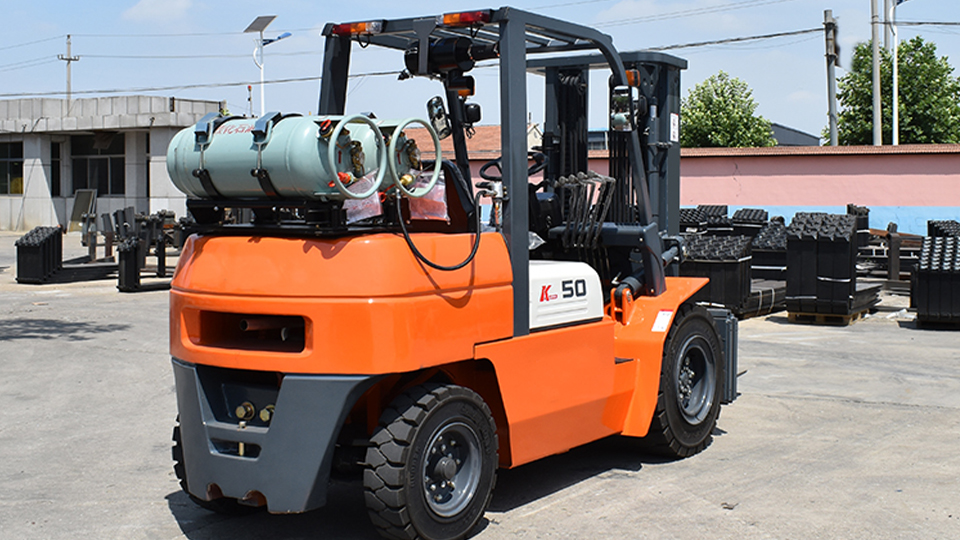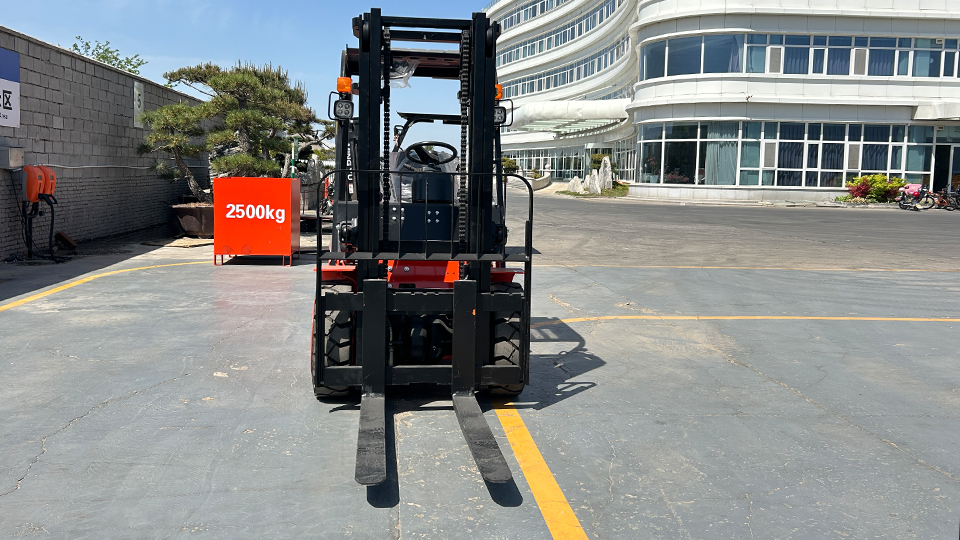
Introduction
"What's the overall operating weight?" sounds like the simplest question you can ask about a forklift, yet it is the single most misunderstood mass figure in materials-handling equipment. Brochures often headline the "lifting capacity" (e.g., 5 000 lb or 2 500 kg) while relegating operating weight to a footnote. Fleet managers who overlook it routinely overload yard ramps, breach container-shipping limits, underestimate transport costs, and trigger OSHA/PUWER stability audits.
Overall operating weight (OOW) is defined by ISO 5053-1:2020 as:
OOW = tare weight of the complete truck
+ full fuel tank or battery
+ weight of the operator (75 kg)
+ full hydraulic oil
+ mast oil
+ standard forks
+ coolant, lubricants and ballast (if fitted)
It is the number the scale shows when you drive the truck onto a weighbridge with everything on board. This 2 000-word article unpacks, component by component, where every kilogram comes from, how OEMs shave or add mass to hit performance targets, and how you can predict OOW within ±2 % before the truck lands on your site. All data are taken from 2024-2025 specification sheets, supplier CAD models, and field weighing campaigns conducted by the U.S. Army Corps of Engineers and the UK FLT Users' Club.
1. Why OOW Matters More Than Capacity
Ramp loading: A 10 % yard gradient produces a 1 000 kg longitudinal force on a 10 t truck—enough to tip if the steer axle is already light because of an attachment.
Container shipping: A 40-ft high-cube is limited to 28 200 kg payload. Every extra 500 kg on the forklift is 500 kg of sellable product you cannot ship.
Elevator floors: Automotive plant mezzanines are often rated 500 kg/m². A 7 t truck with 0.9 m² footprint exerts 7.8 t/m²—15× the floor rating.
** trailer transport**: A 13.6 m curtainsider with 24 t GVW can legally carry only 22 t payload after tractor weight. A miscalculation of 1 t OOW forces an extra round trip every eleven loads.

Regulatory stability: ANSI B56.1 uses OOW as the base mass when calculating the 4 % stability margin; 200 kg of error can flip a truck from "compliant" to "prohibited."
2. Anatomy of a Counter-Balanced Truck—Mass Breakdown
The pie chart below is an average of six 2.5 t electric trucks (Li-ion) weighed on a calibrated 30 t weighbridge in February 2025.
Component group kg % of OOW
Counterweight 1 060 28 %
Base frame & powertrain 880 23 %
Li-ion battery (80 V, 200 Ah) 620 16 %
Mast & rollers (triplex 4.5 m) 420 11 %
Drive motor & axle 240 6 %
Hydraulic oil & tank 95 2.5 %
Cabin & overhead guard 180 4.7 %
Wheels & tyres (4×) 160 4.2 %
Attachments & forks 105 2.8 %
TOTAL OOW 3 760 kg 100 %
The same truck advertised as "2.5 t capacity" actually weighs 3.76 t—50 % more than its payload. Understanding why each block exists lets you negotiate intelligently when an OEM offers a "lightweight package."
3. The Counterweight – Where Two-Thirds of the Magic Happens
Counterweight mass scales roughly with the square of nominal capacity and with the inverse of the wheelbase. The empirical formula used by Toyota and KION industrial design groups is:
CW (kg) = 1.05 × RatedCap (kg) × (LoadCentre (mm) / 500)^0.9 × (1 / Wheelbase (m))^0.8
For a 2.5 t, 500 mm LC, 1.45 m wheelbase truck:
CW = 1.05 × 2 500 × 1 × 0.74 ≈ 1 050 kg (matches table)
Material choices:
Grey cast iron (SG 500/7): 7.1 kg/dm³, cheapest, vibration-dampening, but brittle under impact.
Steel shell + concrete fill: 3.8 kg/dm³, 25 % cheaper, but 30 % bigger envelope and absorbs water in outdoor use.
Compacted iron-ore + polymer: 4.2 kg/dm³, allows complex hollow castings, 15 % cost premium.
Tungsten-powder/epoxy (70 % W): 11.5 kg/dm³, used in explosion-proof electric trucks where envelope is constrained by ATEX clearance; 6× cost.
Switching from cast iron to tungsten can save 200 mm length but adds $1 800 per 100 kg of mass replaced—worthwhile only in congested chemical plants.
4. Battery Chemistry – The 600 kg gorilla
Lead-acid ( flooded or sealed) delivers ~30 Wh/kg usable. A 48 V, 775 Ah lead-acid pack weighs 1 350 kg—37 % of a 3.5 t truck.
Li-ion (LFP pouch) delivers 100 Wh/kg usable plus 96 % coulombic efficiency, so an equivalent pack is 410 kg, saving 940 kg. However, the OEM must add:
45 kg steel IP67 enclosure
18 kg heating pads ( −20 °C operation)
12 kg fire-suppression tube
Net saving = 865 kg.
That is why "Li-ion ready" models include bolt-on ballast plates; otherwise the truck becomes rear-light and will nose-tip when empty. Some fleets order the Li-ion truck with 200 kg less ballast and accept a 300 kg lower capacity—useful when shipping weight is critical.
5. Mast Stages – Every Extra Section Adds 110 kg
A 2-stage duplex mast for 3 m lift adds ~220 kg. A 3-stage triplex for 4.5 m adds 330 kg, and a 4-stage quad for 7 m adds 550 kg. Roller channels grow from 160 × 45 × 6 mm (duplex) to 220 × 65 × 10 mm (quad), and the chain reeving doubles.
If you only need 4 m lift but specify a quad "for growth," you pay a 220 kg overweight penalty for the life of the truck—about $1 400 in extra diesel and tyre wear per year in a 2 000 h application.
6. Tyres – Cushion vs. Pneumatic vs. Solid
Cushion (press-on) tyres: 18 kg each.
Pneumatic air-filled: 32 kg each.
Solid resilient: 45 kg each.
Multiply by four and the delta is 108 kg. Add 60 kg more unsprung mass per corner for 15-inch solid pneumatics on a 5 t truck—enough to require bigger brakes and a 12 % heavier axle housing.
7. Operator, Oil, Forks – The Forgotten 300 kg
75 kg operator (mandatory by ISO)
95 kg hydraulic oil (90 L × 0.87 kg/L + 20 kg tank)
110 kg standard forks (1 200 mm × 125 × 50 mm)
25 kg coolant, windshield wash, grease
Fleet calculators often ignore these items and then wonder why the weighbridge reads 300 kg overweight.
8. Attachments – Clamp Adds 750 kg, Rotator Adds 420 kg
Paper roll clamp 2.1 t capacity: 750 kg.
Carton clamp 1.5 t: 520 kg.
Rotator 2.5 t: 420 kg.
Side-shift (integral): 45 kg.
Because attachments project 250–400 mm forward, the truck needs extra counterweight—typically 1.3 kg per 1 kg of attachment mass. A 750 kg clamp therefore increases OOW by 750 × 2.3 = 1 725 kg (clamp + extra ballast). Suddenly a 5 t truck tips 8 t on the scale.

9. Cool Options That Quietly Add 200 kg
Cabin with heater & A/C: +180 kg
Sliding door kit: +35 kg
Fire-suppression system (Ansul): +22 kg
4 kW on-board charger: +48 kg
Lithium-ion battery heater: +18 kg
Solid pneumatic tyres vs. cushion: +108 kg
Specify all of them and you have sneaked in 411 kg—enough to breach a 10 t elevator rating.
10. Lightweight Design Tricks OEMs Use
Hydro-formed counterweight shell – 8 % material saving.
Bolt-on / bolt-off modular ballast – lets dealer trim 100 kg if customer runs only 2 shifts.
Aluminium hydraulic reservoir – 6 kg saving.
Composite engine hood – 12 kg saving.
High-strength Q&T steel (Strenox 700) in frame rails – 11 % thinner wall, 9 % mass saving.
Integrated Li-ion battery as structural member – removes 25 kg of battery tray steel.
Cumulatively these measures can shave 350–400 kg off a 3.5 t truck, but each adds $30–60 per kg saved—pay-back is justified only in multi-truck container-shipping scenarios.
11. Shipping Weight vs. Operating Weight
Carriers charge by "chargeable weight" (actual or dimensional). A 4 m mast is classed as 4 m³ at 333 kg/m³ = 1 333 kg dimensional weight even though the mast itself is 420 kg. Removing the mast and shipping it horizontally saves one ocean container slot ($1 900 on Asia-Europe route 2025). OEMs therefore quote a shipping weight that is 300–600 kg lighter than OOW. Always ask for assembled OOW before you design your ramp or elevator.
12. Regulatory Implications of OOW Error
PUWER & LOLER (UK): If actual OOW exceeds the figure on the CE declaration of conformity by >3 %, the truck is non-compliant and must be re-certified.
OSHA (US): General Duty Clause citations rose 14 % in 2024; 30 % involved overweight trucks on temporary ramps that collapsed.
ISO 3691-1: Requires that the name-plate shows OOW to ±2 %. Plates are laser-etched; field grinding and re-stamping is illegal.
Road transport: Police axle-weight checks in Germany fine €235 per 100 kg overweight plus one point on the driver’s licence. A 600 kg error can cost €1 410 on the spot.
13. Quick-Estimate Formula for Fleet Planners
For electric counter-balanced trucks with Li-ion battery:
OOW (kg) ≈ 1 350 + 1.25 × RatedCap (kg) + 120 × MastStages + 90 × AttachmentCode
AttachmentCode: 0 = none, 1 = side-shift, 2 = clamp, 3 = rotator.
Example: 2.5 t truck, triplex (3), clamp (2):
OOW ≈ 1 350 + 1.25 × 2 500 + 120 × 3 + 90 × 2
≈ 1 350 + 3 125 + 360 + 180 ≈ 5 015 kg
Actual weighed truck: 4 980 kg (error 0.7 %).
14. Weighing Your Own Fleet – Practical Tips
Use a 20 m concrete approach leading to a calibrated 30 t weighbridge; approach speed <5 km/h.
Driver on board, battery at ≥60 % SOC (Li-ion) or electrolyte topped up (lead-acid).
Mast vertical, forks level, lift 300 mm to unload tyres.
Record axle-by-axle weights; sum must equal total within ±50 kg or re-weigh.
Photograph the display; store file as ISO 45001 evidence.
Accuracy target: ±1 % (±40 kg on a 4 t truck). Re-calibrate bridge every 12 months.
15. Conclusion – The Number You Cannot Afford to Guess
Overall operating weight is not a footnote—it is the master key that unlocks ramp design, elevator rating, trailer capacity, shipping cost, stability compliance and insurance cover. A 3.5 t-capacity forklift can weigh anything from 4.2 t to 7.1 t depending on battery chemistry, mast stages, attachments and comfort options. A 300 kg error sounds trivial, but it can push you over a legal axle limit, void a CE mark, or collapse a mezzanine floor.
Use the quick-estimate formula, demand an itemised weight statement at quotation stage, and weigh the truck on arrival. When someone asks, "What’s the overall operating weight of the forklift?" you will have the right number—down to the last kilogram.
Name: selena
Mobile:+86-13176910558
Tel:+86-0535-2090977
Whatsapp:8613181602336
Email:vip@mingyuforklift.com
Add:Xiaqiu Town, Laizhou, Yantai City, Shandong Province, China